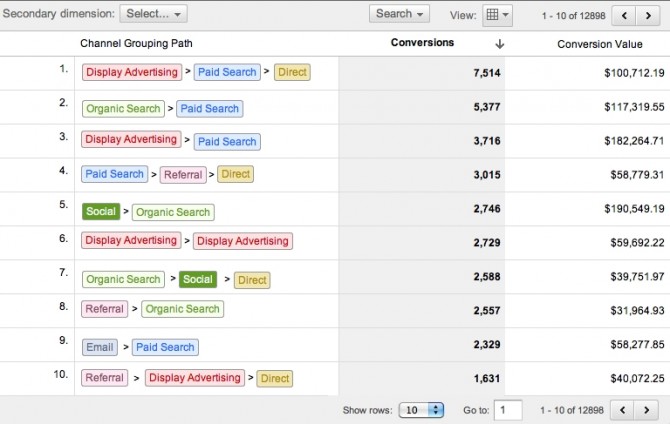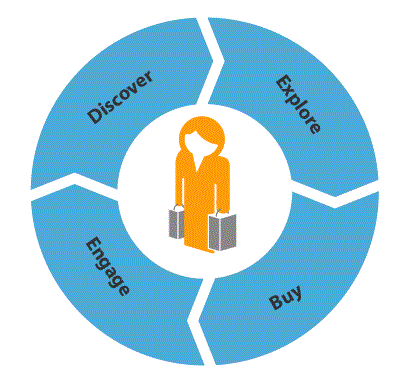Editor’s Note: This article was originally published by Web Marketing Today. Practical Ecommerce acquired Web Marketing Today in 2012. In 2016, we merged the two sites, leaving Practical Ecommerce as the successor.
For more than a century, the conventional wisdom in marketing was that customer buying decisions followed a linear, top-down progression known as the funnel.
Capturing consumer interest at the top of the funnel was essential. Companies then used specific, dedicated strategies at each stage of the funnel, guiding the customer through the entire purchase process.
Today, however, the marketing funnel is nearly obsolete. The new customer path to purchase is much more winding and sophisticated, and smart companies have begun to adapt to the new approach.
What Is the Funnel?
Developed in 1898 by American advertising advocate E. St. Elmo Lewis, the funnel focuses on four key stages in the consumer lifecycle: Awareness, Interest, Desire, and Action.

AIDA marketing funnel model.
As the theory goes, a prospect must first become aware that a particular product exists, and then develop an interest in obtaining it. After narrowing the options, the prospect begins to desire a specific type, model, or brand and then takes action, making the purchase.
The funnel worked well even after radio came onto the scene in the 1920s and television in the early 1950s. The medium might have changed, but the sales and marketing process was still mostly linear.
Advancements in product shipping gave prospects additional options, but comparison-shopping was mainly limited to what consumers could glean from advertising and in-store displays.
As consumers became increasingly sophisticated, the original funnel morphed into the purchase funnel, with a new focus on shoppers’ opinions, preferences, and consideration. Still, it remained an extremely linear process in which sales and marketing team members played a crucial role in influencing customers’ decisions.
Why Is the Funnel Obsolete?
The rise of the Internet gave consumers more options than ever before. Even more importantly, prospects now have the ability to perform many of the funnel tasks on their own. From researching features to talking to current product owners, consumer education has largely become a do-it-yourself effort.
Prospects engage with companies at various points in the process, and each comes to the interaction with a different level of knowledge, interest, and sophistication. What was once a linear, guided process is now a complex, non-linear journey.
The New Path to Purchase
The new path to purchase cannot be easily summed up in a few words because it is highly individualized to each consumer. Nonetheless, the vast majority of consumers hit certain milestones along the way.
In an article for Forbes, Steven Noble, senior analyst at Forrester Research, detailed four primary phases in a customer’s lifecycle:
- Discover. This phase is analogous to the funnel’s Aware phase and stresses the continued importance of marketing strategies that let prospects know about your company. In an increasingly crowded marketplace, standing out is crucial.
- Explore. This phase encompasses all the complex tasks that today’s sophisticated consumers perform when shopping for an item. Extensive Internet searches, hands-on experimentation, such as test-driving a car, reading reviews, and many other events may occur during the Explore phase. Interestingly, while the funnel model relied on narrowing options in each step, today’s consumers are likely to expand their list of possibilities during this stage as they learn the pros and cons of many different solutions.
- Buy. At this point, prospects are ready to complete a transaction. Yet they may go through a few more iterations before making the purchase. Looking for coupons or promo codes, revisiting a short list of online or brick and mortar stores, and searching for sales are typical behaviors. Once a retailer is selected, all phases of the buying experience must be seamless and easy to execute, or the consumer is likely to go elsewhere.
- Engage. Here, the consumer interacts with the chosen brand in vital new ways. Using the product or service, visiting the website for usage ideas, and engaging with others are just a few examples. This is the chance for a savvy company to build brand loyalty and word of mouth advertising.

The new customer lifecycle marketing model. (Source: Forrester)
Tailoring Your Campaigns for the New Path
Cross-channel marketing technology company Signal recently released an infographic that explains how companies can guide consumers through their new, more complex journey to purchase. They recommend following the three “C’s”:
- Create a seamless cross-platform experience. Most consumers move back and forth between smartphones, computers, and tablets during their journey. Make it as easy as possible for them to return to your site, no matter which device they choose.
- Capture attention. According to Signal, response times of more than one second put you at risk of losing prospects. Times measured in milliseconds are ideal. Make sure your site loads rapidly across all devices and make it worthy of your prospects’ time.
- Calibrate to each customer. One size fits all solutions simply do not work in the modern marketplace. Consumers come to your website from all phases of their purchasing journey. Some are ready to buy. Some are browsing for information. Some have a lot of time to read details, and some are just popping in. Customized real-time content meets each customer where he or she is at the moment, vastly improving your chances of making a sale.
Google Analytics offers a tool to help you analyze how all your marketing channels work together to create conversions. Known as Multi-Channel Funnels, this tool provides detailed information on the paths your customers took throughout their buying journey, as well as how long it took them to convert to paying customers.

Google Multi-Channel Funnel tracks customer path to purchase.
When building your new marketing campaigns, all the basic rules for creating an excellent campaign still apply. However, they are no longer enough on their own. Today, you must tailor your marketing campaigns for all devices. If your web pages don’t work well on certain devices, you will ultimately lose sales.




